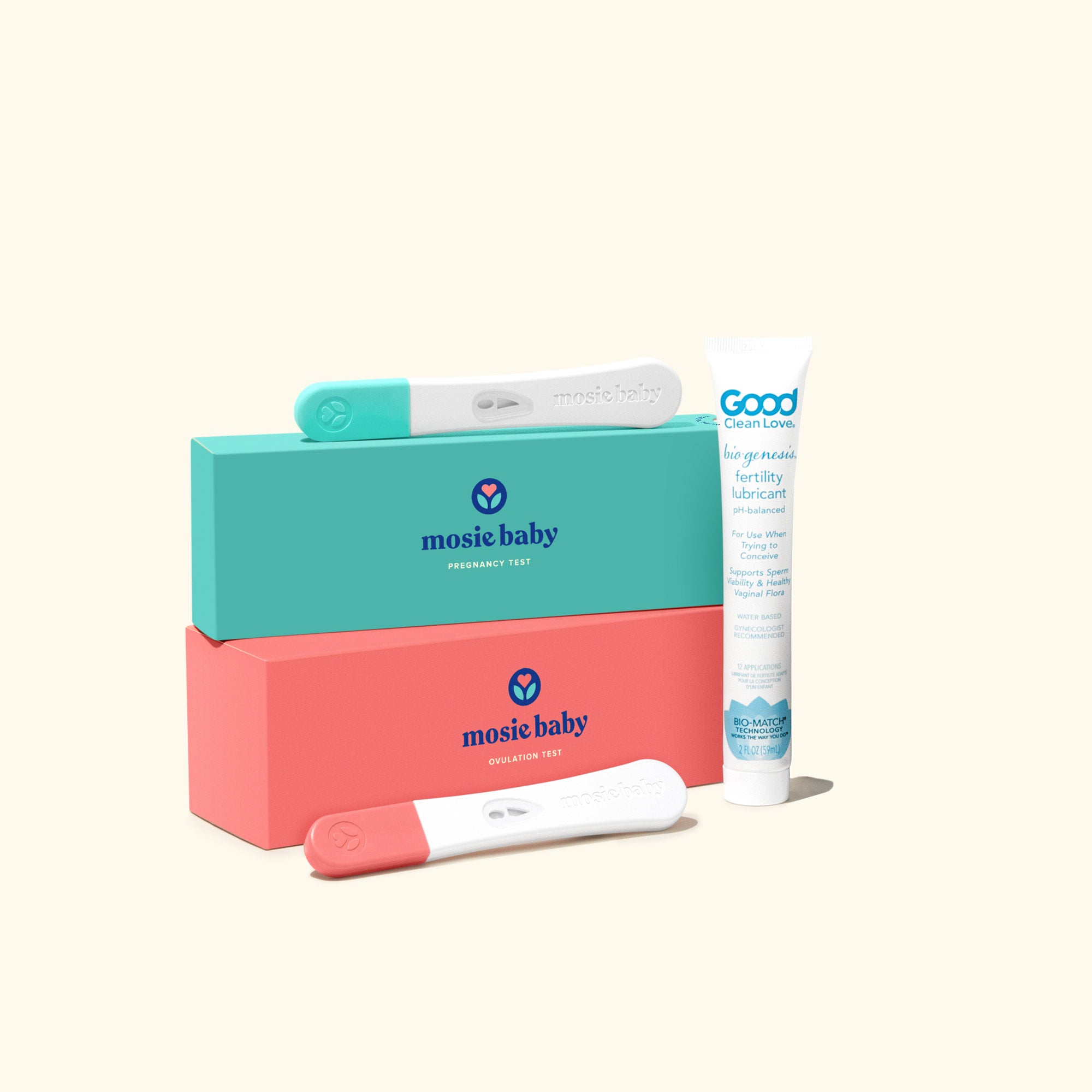If you’ve been trying to conceive for a while without success, then you have probably heard of the alphabet soup of fertility acronyms: IVI, IUI, and IVF. They stand for intravaginal insemination, intrauterine insemination and in vitro fertilization. These are the most common insemination options. Some people might end up needing to do all three at different times throughout their trying to conceive (TTC) journey. With all of the information out there, it can be confusing and overwhelming understanding the differences between them– and figuring out which one is right for you.
Now that you are here, take a deep breath and relax – we’ve got this! We’ll explain each of these procedures – so you can have more information as you plan your next steps. Always consult your doctor if timed intercourse isn't working or isn't an option.
What are the different methods of artificial insemination?
Artificial insemination is a procedure where sperm is introduced to a person’s uterus, cervix, or vagina without sexual intercourse. Basically, when anything besides a penis places the sperm inside the female reproductive system. The two most popular forms of artificial insemination are: Intravaginal insemination (IVI) and Intrauterine Insemination (IUI).
Intravaginal Insemination (IVI) is the process of delivering sperm directly into an anatomically female reproductive tract, at or near the cervical opening located inside the vagina –the entryway to the uterus. You can do this either at home or at a doctor’s office. At home IVI utilizes a syringe to deliver the sperm at or near the cervix. To be the most effective, it’s important to time the insemination to your fertile window– so that the sperm gets to the cervix before ovulation occurs.
Intrauterine Insemination (IUI) is the process of putting sperm directly inside your uterus. This medical procedure should only be done at a doctor’s office by a medical professional, and is often done in combination with ovulation inducing and stimulating drugs. A doctor will typically monitor the patient’s menstrual cycle, and follicular growth with blood tests and vaginal ultrasounds. The IUI procedure is timed to occur within 24 to 36 hours before ovulation.
Specifically, during an IUI the sperm sample needs to be processed or “washed”. This process separates the sperm from the semen, removes any non-moving sperm, dead cells and debris.
To perform the IUI, the doctor attaches a vial, filled with the washed sperm, to the end of a long, thin, and flexible tube called an IUI catheter. The catheter is then inserted into the vagina, then through the cervical opening and into the uterus – where the vial filled with sperm is released
Comparing the procedures of IVI, IUI and IVF
Intravaginal insemination (IVI), Intrauterine Insemination (IUI), and in vitro fertilization (IVF), are three procedures designed to help people conceive. IUI and IVF are medical procedures that are done by a doctor, at a fertility clinic or surgery center. IVI is typically a do-it-yourself process, done at home with a syringe.
IVI and IUI are similar in that they both introduce sperm into the reproductive tract, vs IVF where the sperm and the egg are combined in the laboratory, outside the body. An IVI delivers sperm at or near the cervical opening, an IUI delivers sperm past the cervix and into the uterus. In Vitro Fertilization, however, is a completely different process.
The IVF procedure requires a person with a uterus and ovaries take injectable hormones for several weeks, so that several eggs mature at the same time. Then a doctor surgically retrieves the viable eggs. In a lab, the eggs are either mixed with “washed sperm”, or each of the eggs are injected with one carefully selected sperm in a procedure called intracytoplasmic sperm injection (ICSI). The fertilized eggs are then monitored carefully for their development in a lab. A few days after the eggs fertilize, and become embryos, a doctor transfers one of more of the healthy embryos directly into the uterus. The embryo hopefully implants, and begins to develop inside the uterus. Alternatively, patients may elect to freeze all of their embryos and undergo a frozen embryo transfer at a later date.
Advantages & Disadvantage analysis of IVI vs. IUI vs. IUI
Intravaginal Insemination (IVI) is the simplest and least expensive option of the three techniques. Depending on the laws in your state or country, it often is the only procedure that can be done independently without medical intervention. In vitro fertilization (IVF) is the most invasive and expensive. However, there are cases where IVF is the only feasible option. For example, if a person’s fallopian tubes are tied, burned, damaged, or removed, or if a male partner can’t produce enough sperm through ejaculation.
With IUI, and IVF - but not IVI, a partner's sperm is screened and cleaned before being used, which is sometimes necessary with certain types of male factor infertility.
If you’re a good candidate, IVI is easy to do at home. It can also be done with fertility enhancing drugs under the guidance of a physician. If working with a known sperm donor, you’ll want to look into doing your own screening for STDs, infectious diseases, and sperm health.
IUI is typically the first “doctor-assisted” insemination procedure that people try. But before starting any procedure, your doctor will do a full assessment to try and figure out why you might be having trouble conceiving.
For some IVF is the only option. It can also be an alternative for those with cervical issues, severe endometriosis that hasn’t responded to treatment, or people who have not achieved success with other less invasive interventions.
All three fertility options may require multiple attempts. That’s why if it’s possible, many people like to try a “leveling up” plan. This allows people to try and conceive with the least expensive and least invasive methods first, before moving on to other options.
Comparing the costs of IUI, IVF and IVI
The cost of an IUI or IVF cycle depends on whether you have insurance coverage for these medical fertility procedures. Plus, there are additional laboratory and medical fees to consider, which may not be covered.
If you are paying out of pocket for an IUI procedure, it typically costs between $400 and $3,000 per attempt (not including medications, if needed).
In Vitro Fertilization, without insurance, costs between $10,000 and $50,000. The medications required for the IVF process cost an additional $1,500 to $4,000 per cycle. Some fertility clinics offer package deals that include more than one attempt in their pricing. There are also additional fees for things like preimplantation genetic testing for aneuploidy (PGT-A) – which is a procedure used to help identify genetic defects within embryos. So, the average IVF patient can expect to spend $30,000 to $60,000 - if their insurance does not cover the procedure. This is why many opt to shop around to find the most affordable IVF options, and some even travel to other states, or countries for treatment.
The only cost of doing Intravaginal Insemination (IVI) at home is for the insemination kit itself. If you are using a known donor, additional costs to consider are sperm analysis, STD testing, and arrangement of any legal documentation.
Many people have used various types of syringes throughout history.If you decide to do IVI at the doctor’s office, you should check to see what fees they charge per attempt.
Comparing the typical success rates of IUI, IVF and IVI
When you look at the statistics for success rates, you should keep in mind that they are only an average, and that everyone has their own mitigating factors to throw into the mix. For example, variables like your age, fertility medication use, and any underlying medical conditions, all impact success rates. But for some, knowing the averages helps to keep your expectations grounded.
According to a study published in the journal human reproduction, where "sperm was deposited near the cervical canaI" is 37.9% after 6 cycles.
When it comes to intrauterine insemination (IUI) – according to a study published in the journal human reproduction, the success rate for IUI is 40.5% after 6 IUI cycles. If you’re under the age of 35, you have a 10 to 20 percent chance of success with each attempt. If you’re 35 to 40 years old, you’re looking at a success rate of around 5 percent. The number drops significantly for females over the age of 40 – who have a success rate of between two and five percent. Those success rates could improve if fertility drugs are used in combination with the IUI process. The number of IUI attempts is also a factor. The best chance of success is typically within the first three to five tries.
The average success rate of in vitro fertilization (IVF) changes dramatically, depending on your age. Women under the age of 35, have a nearly 40 percent chance of conceiving each cycle. Depending on the diagnosis, women 40 and older have approximately a 12-15% percent chance of success per cycle.
For comparison, in young, fertile couples having intercourse, the average rate of success per month is about 15-20 percent.
The bottom line is that everyone is unique. There is not a one-size-fits-all situation. So, your path to finding the family of your dreams, is about what’s best for you - not your sister, or your best friend. We hope this information has helped, and we wish you success! Please feel free to reach out if we can help support you on your journey to conceive in any way. Crossing fingers for you!


